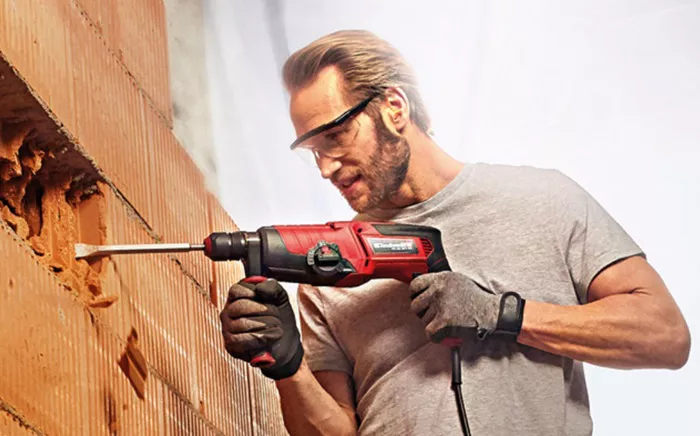Choosing the right drill for your project can significantly affect the ease and quality of your work. Two common types of drills are the impact drill and the hammer drill. Understanding their key differences can help you make an informed decision.
1. Mechanism of Action
Impact Drill
Rotational Force: An impact drill uses a rotational hammering action to drive screws and bolts. The internal mechanism produces a sudden, high-torque output when resistance is encountered, allowing the drill to drive fasteners efficiently.
Impacts Per Minute (IPM): The impact mechanism delivers rapid, short bursts of power, measured in impacts per minute, which enhances its ability to drive fasteners into hard materials.
Hammer Drill
Hammering Action: A hammer drill combines rotary motion with a hammering action. The internal mechanism moves the drill bit back and forth rapidly, allowing it to chisel away at the material as it drills.
Blows Per Minute (BPM): The hammering action is measured in blows per minute, indicating how many times the drill bit strikes the surface. This action is particularly useful for drilling into hard materials like concrete and masonry.
2. Best Applications
Impact Drill
Driving Fasteners: Impact drills excel at driving screws, bolts, and fasteners into tough materials. The high torque output makes it ideal for automotive work, construction, and heavy-duty fastening.
Metal and Woodwork: It is well-suited for tasks involving metal and wood, where precision and control are required.
Hammer Drill
Masonry and Concrete: Hammer drills are designed for drilling into hard surfaces like concrete, brick, and stone. The hammering action breaks up the material, making it easier to drill holes.
General Drilling: While they can be used for general drilling tasks, they are particularly effective for applications that require penetrating hard surfaces.
See also: What Is A Hammer Drill? Features, Uses, And Benefits
3. Power and Torque
Impact Drill
High Torque: Impact drills deliver high torque, making them capable of driving large fasteners and working with dense materials. This high torque is achieved through the impact mechanism that provides bursts of rotational force.
Variable Speed: Many impact drills offer variable speed settings, allowing users to adjust the torque and speed based on the task at hand.
Hammer Drill
Moderate to High Power: Hammer drills offer moderate to high power, depending on the model. The combination of rotary and hammering action provides effective drilling power for hard materials.
Speed and Power Settings: Some hammer drills come with adjustable speed and power settings, allowing users to switch between standard drilling and hammer drilling modes.
4. Design and Ergonomics
Impact Drill
Compact and Lightweight: Impact drills are generally more compact and lightweight compared to hammer drills, making them easier to handle and maneuver in tight spaces.
User Comfort: The ergonomic design of impact drills reduces user fatigue, especially during prolonged use. The handle design and weight distribution contribute to a comfortable grip.
Hammer Drill
Heavier Build: Hammer drills tend to be bulkier and heavier due to the additional hammering mechanism. This extra weight can provide stability but may also cause fatigue during extended use.
Dual Handles: Many hammer drills come with dual handles to provide better control and reduce strain during heavy-duty tasks.
See also: 10 Best DeWalt Drill Attachments And Accessories
5. Noise and Vibration
Impact Drill
Lower Noise: Impact drills are generally quieter compared to hammer drills, making them suitable for indoor use where noise levels need to be minimized.
Reduced Vibration: The impact mechanism reduces the amount of vibration felt by the user, contributing to a more comfortable drilling experience.
Hammer Drill
Higher Noise Levels: The hammering action generates more noise, which can be disruptive in indoor environments. Ear protection is recommended during use.
Increased Vibration: The hammering action also produces significant vibration, which can lead to user fatigue and requires a firm grip for control.
6. Versatility and Accessories
Impact Drill
Wide Range of Attachments: Impact drills are compatible with a variety of attachments and accessories, such as screwdriver bits, socket adapters, and drill bits for metal and wood.
Multi-functional: The versatility of impact drills makes them suitable for a wide range of tasks, from construction to automotive repair.
Hammer Drill
Specialized Bits: Hammer drills require specialized masonry bits for effective drilling into concrete and stone. These bits are designed to withstand the hammering action and provide clean holes.
Specific Use Case: While versatile, hammer drills are best suited for tasks that involve hard materials, limiting their use for other general drilling tasks.
Conclusion
Choosing between an impact drill and a hammer drill depends on your specific needs and the tasks you plan to undertake. If your projects involve driving fasteners and working with metal or wood, an impact drill is likely the better choice due to its high torque and precision. On the other hand, if you need to drill into concrete or masonry, a hammer drill’s hammering action will make the job much easier. Understanding the key differences in their mechanisms, applications, power, design, noise levels, and versatility will help you select the right tool for your projects.
Related Topics:

